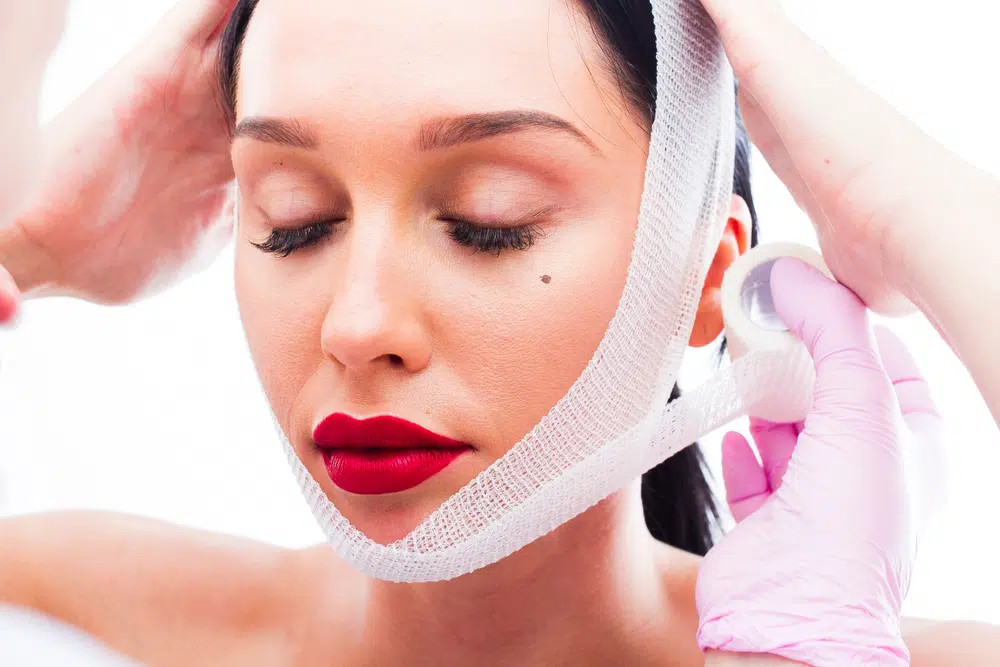
Bruising and swelling are part of your body’s natural healing response. Whether you’ve had a deep plane facelift, eyelid surgery, nose surgery, body procedure, laser treatment, or a less invasive facial procedure, some degree of bruising and swelling is expected.
These symptoms happen because surgical trauma causes small blood vessels under your skin to break. Your body sends fluids to the area to start repairing the tissue, leading to temporary discoloration and puffiness.
It might not look pretty, but this is your body doing exactly what it’s supposed to do.
Essential Tips for Bruising Post-Surgery
- Bruising and swelling are normal symptoms of healing and happen with both surgical and non-surgical procedures like facelifts, liposuction, fillers, and laser treatments
- The amount of bruising varies between individuals depending on factors like skin type, procedure, and how your body responds to surgical trauma
- Facial surgery often causes visible swelling, which can be managed with head elevation, cold compresses, and a low-sodium diet in the first week
- Compression garments, hydration, and light movement help reduce swelling after body surgeries and speed up overall recovery
- Bruising can last 1–2 weeks depending on the procedure and area treated, but proper aftercare, rest, and support will lead to steady, visible improvement
What to Expect From Bruising Post-Surgery
During the first week, bruising and swelling are usually most noticeable. Facial areas like the cheeks, eyelids, or nose can look more swollen than they feel. Body procedures like liposuction or tummy tucks may cause larger bruises that take more time to fade.
Every patient is different. Some see mild swelling and minimal bruising, while others experience deeper discoloration that lasts longer. These differences depend on your skin type, the procedure you had, and how your body reacts.
But no matter how visible it is, bruising and swelling are temporary. They fade — always.
Complications or Normal Symptoms? How to Tell the Difference
Swelling and bruises that slowly improve are a sign of progress, not a problem. However, watch out for signs like warmth, redness that spreads, increasing pain, or pus. These could mean infection and should be checked by your provider.
Knowing what’s normal and what’s not can ease your mind and help you trust the process.
Facing the Mirror: The Emotional Side of Recovery
Let’s be honest — even if your body is healing, looking in the mirror after surgery can feel overwhelming. You may feel discouraged, especially if bruises are still there when you’re ready to return to work or go out. You might question if something went wrong or feel anxious about what others will think.
These feelings are valid. You’re not alone. Many patients go through this emotional dip during the early healing phase. It’s okay to feel unsure. But this part of recovery doesn’t last forever.
Your appearance will change day by day, often quicker than you expect.ance, dyes, or pore-clogging ingredients. If you normally have sensitive skin, then be especially careful to take extra care in choosing the right formula for your post-surgical use.

Tips for Bruising and Swelling After Facial Plastic Surgery
(Deep plane facelift, eyelid surgery, nose surgery, chin liposuction, etc.)
Facial procedures can lead to more visible swelling due to the delicate nature of facial tissues. Here’s how to manage it:
- Sleep with your head elevated (using 2 pillows or a wedge) for at least 1–2 weeks.
- Apply cold compresses for the first 48 hours (15–20 minutes on, then off) to reduce early swelling.
- Avoid bending over or heavy lifting, as this can increase facial pressure and worsen swelling.
- Limit salt intake, as sodium can cause your body to hold onto fluids and prolong puffiness.
- Keep your face still — avoid excessive chewing, yawning, or talking in the first few days.
- Use gentle, cool water to cleanse your face and avoid any harsh products until cleared by your surgeon.
- Be patient — most swelling improves within 10–14 days, but minor puffiness may last several weeks.
Tips for Bruising and Swelling After Body Surgery
(Liposuction, tummy tuck, breast augmentation/reduction, BBL, etc.)
Swelling after body surgery often feels more intense and can take longer to resolve. Follow these tips:
- Wear compression garments exactly as instructed — they help reduce swelling and support tissue.
- Walk lightly and frequently to keep blood flowing and prevent fluid buildup.
- Stay hydrated — water helps flush excess fluid and supports circulation.
- Avoid tight waistbands or clothing that might restrict blood flow or put pressure on swollen areas.
- Don’t soak in baths or pools until cleared — swelling can worsen with too much heat or water exposure early on.
- Take short naps with legs elevated, especially after lower body surgery.
- Avoid smoking or vaping, which restricts blood flow and slows healing.
- Swelling can peak around days 3–5, then start to improve gradually.
Tips for Bruising and Swelling After Facial Treatments
(Botox, fillers, chemical peels, microneedling, lasers, etc.)
Even less invasive skin treatments can cause minor swelling and bruising, especially in sensitive areas like the lips, under eyes, or forehead.
- Apply a cold pack gently to the treated area for 10–15 minutes at a time during the first few hours.
- Sleep with your head elevated, especially after dermal fillers or laser treatments.
- Avoid touching or rubbing the area, especially with Botox and fillers.
- Skip intense workouts, alcohol, or hot showers for 24–48 hours post-treatment.
- Don’t schedule back-to-back treatments — give your skin time to calm down in between.
- Avoid NSAIDs (like ibuprofen) unless approved, as they may increase bruising.
- Use gentle skincare — stick with a simple, soothing cleanser and moisturizer.
- Results may improve gradually as the swelling resolves within 3–7 days.

How Long Will I be Bruised? What Can I Do to Reduce Bruising?
After undergoing surgery, those with fair skin and delicate facial features may experience bruising more prominently. The appearance of bruises can vary depending on the individual’s healing time but typically resolve within 1-2 weeks post-op. To reduce bruising, patients can apply cold compresses, elevate their heads while sleeping, avoid alcohol and blood-thinning medications, and gently massage the area to promote circulation. Additionally, incorporating Vitamin K cream or arnica into their skincare routine can help speed up the healing process and achieve a more natural, even-looking skin tone.
Contact Dr. Bustillo and Schedule Your Facial Reconstructive Consultation
Dr. Andres Bustillo, M.D., F.A.C.S. is a facial plastic surgeon with extensive knowledge, experience, and outstanding qualifications. He is board certified by the American Board of Facial Plastic & Reconstructive Surgery and the American Board of Otolaryngology—Head & Neck Surgery — one of a select few double board-certified facial plastic surgeons. As a facial plastic surgery specialist, he does not treat any other area of the body. This specialization allows him to get the best results for patients with a wide range of facial shapes, features, and skin types. He is always on the cutting edge of the latest advancements.
Dr. Bustillo has built his reputation as someone who produces natural, long-lasting results. Over 50 percent of his practice is dedicated to rhinoplasty Miami and revision rhinoplasty . The rest is devoted to other types of facial rejuvenation surgery such as deep plane facelift . He performs over 300 nasal surgeries a year. Twenty-five percent of his patients come from outside the United States. Twenty percent of his patients are other doctors and their families.
You can also directly contact our patient care coordinator, Jessica, by phone at 305-663-3380 or by email through the contact form . The office of Dr. Bustillo is here to answer your questions and help you to plan your initial consultation.

